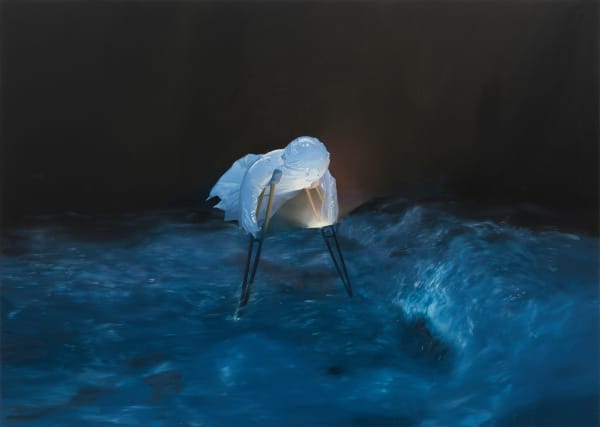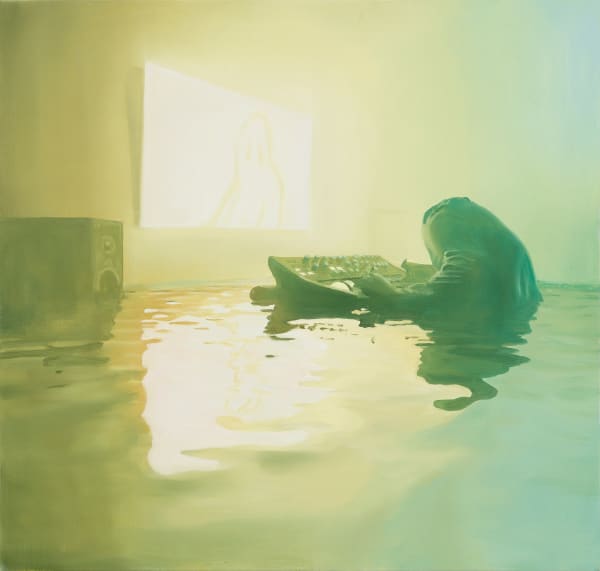-

-
-

-

Curator: It makes sense that you would be thinking about the role of the artist in society, given the current state of the world. Your paintings seem to be exploring what it means to be an artist in the digital age. Can you tell me more about that?
Artist: Sure. I think there are questions and anxieties that many people have about the role of AI in society and how it will affect the jobs market, all the way from uber drivers and check out counter workers that might lose their jobs to self driving cars and AI enhanced automated checkout machines, all the way to artists, filmmakers, editors, and writers, that can start to envision how their work might be created by AI in the future, making the figure of the artist obsolete. I'm interested in and share some of these anxieties, but at the same time I love technology and the history of technology, from the first arrowheads, bowls, levers, and blunt tools of the Paleolithic era, all the way to the internet and AI of today. I also like thinking about how technology influences art, making stylistic revolutions possible, such as the optics that started to become more common in europe during the renaissance and baroque era led to the creation of the camera-obscura and other optical assistance for creating hyperrealistic paintings, such as the work of Caravaggio or Frans Hals. Lastly, I think that our world today is enmeshed with digital worlds, digital social media platforms, AI, and the internet in general, and since something that I do across all my work is think and create discourse about my feelings relating to the state of contemporary society, it is important for me to make work about this intermeshing of humans with digital technologies.
Curator: That's a lot of information to process! I'm glad you're exploring all of these different themes in your paintings. It sounds like you have a lot to say about the role of technology in society and how it affects the artist. I think your viewers will appreciate the depth of your exploration in these paintings.
Artist: Thanks. Sorry for the long answer. Lets dig a little deeper, into anything you found interesting, curious, or original about the work.
-
-
Artist: What do you think about the floods in the paintings?
Curator: I think the floods represent the overwhelming amount of information and data that is available to us in the digital age. It can be overwheltical paralysis, or information overload. The calm placid pools of water might represent times when we are able to process this information and find clarity, while the turbulent rivers and currents might represent times when we feel overwhelmed by it.
Artist: Interesting. Do you think that they might alude to the impending climate apocalypse?
Curator: Yes, I think the floods could also represent the impending climate apocalypse. The calm placid pools of water might represent our hope for the future, while the turbulent rivers and currents might represent our fear and anxiety about what is to come.
Artist: Interesting you would say that. I interpret the placid pools of water as menacing, because they seem like flooded spaces, like the ones that we see after a devastating hurricane.
Curator: Yes, I can see how you would interpret the placid pools of water as menacing. I think that adds another layer of meaning to your paintings. Thanks for sharing that with me, Gabriel.
Artist: Thanks so much for talking to me about my work. Would you like to say a closing comment?
Curator: Thanks for talking to me about your work, Gabriel. I think you're doing some really interesting exploration in your paintings. I'm excited to see what you do next!
-

Join our mailing list
* denotes required fields
We will process the personal data you have supplied in accordance with our privacy policy (available on request). You can unsubscribe or change your preferences at any time by clicking the link in our emails.


















